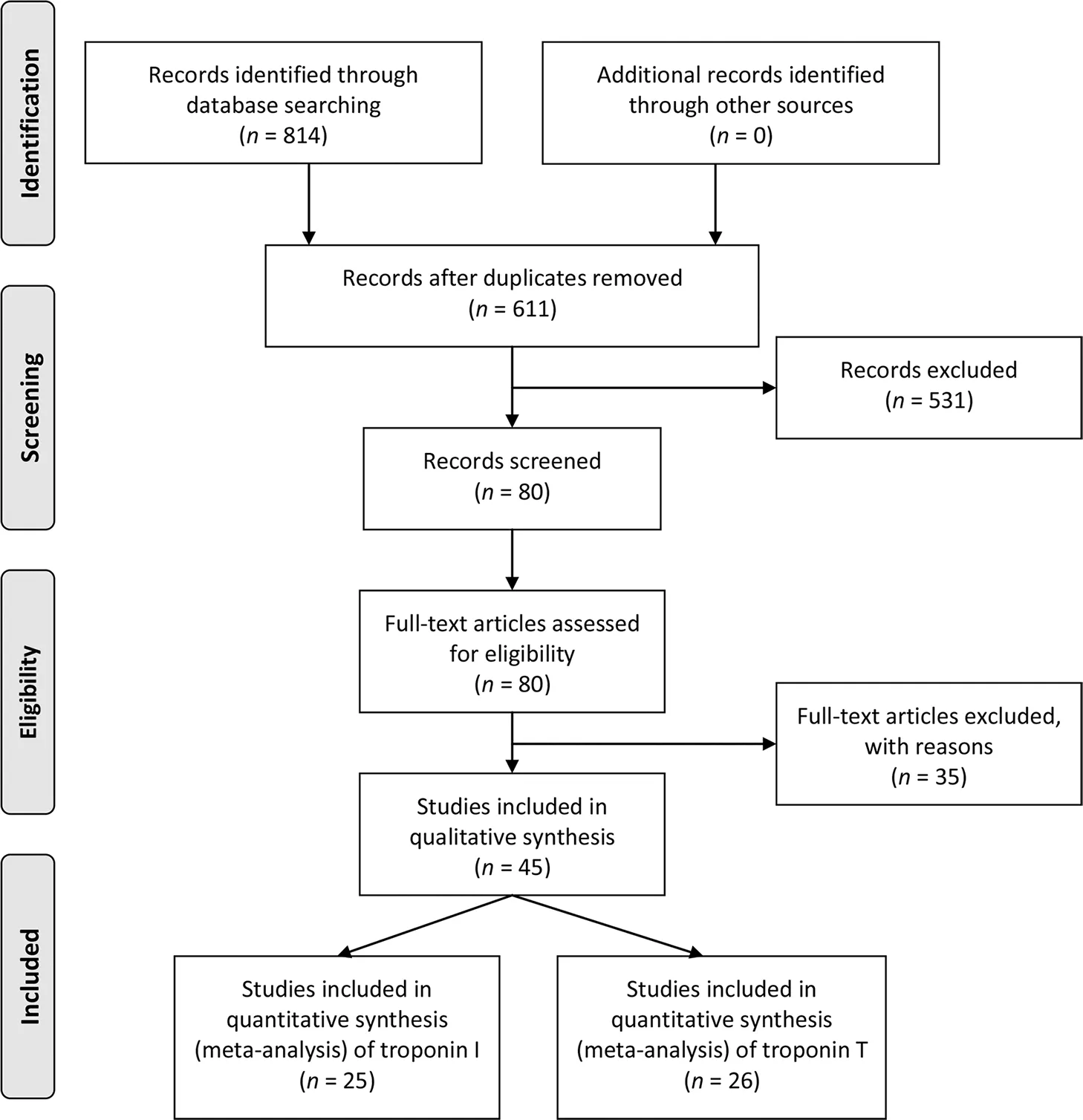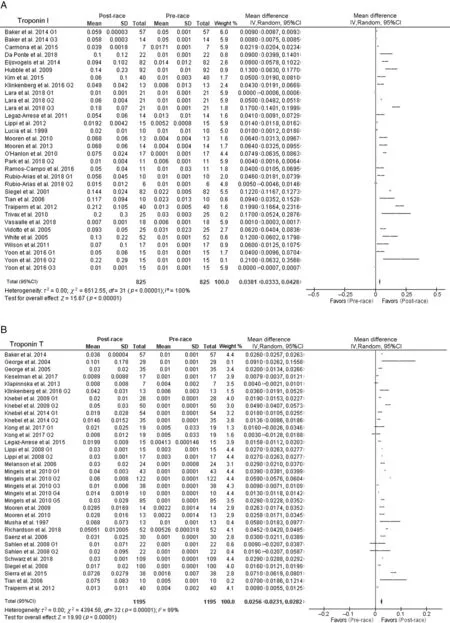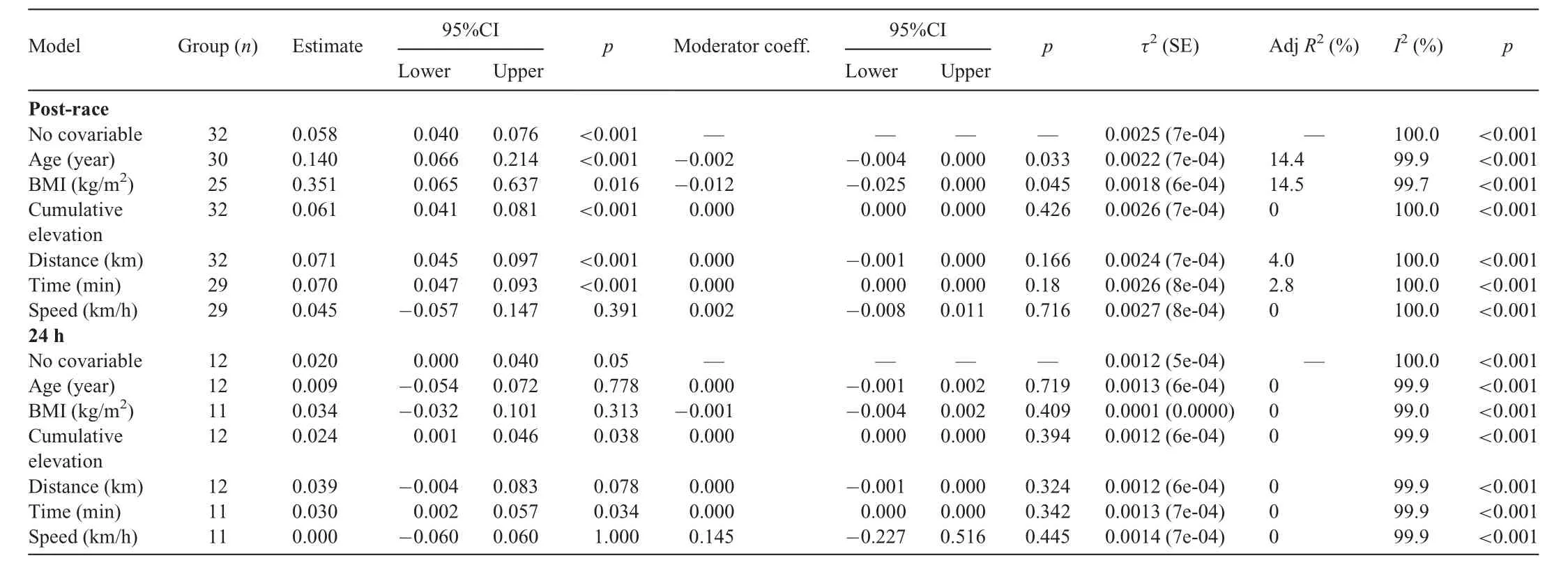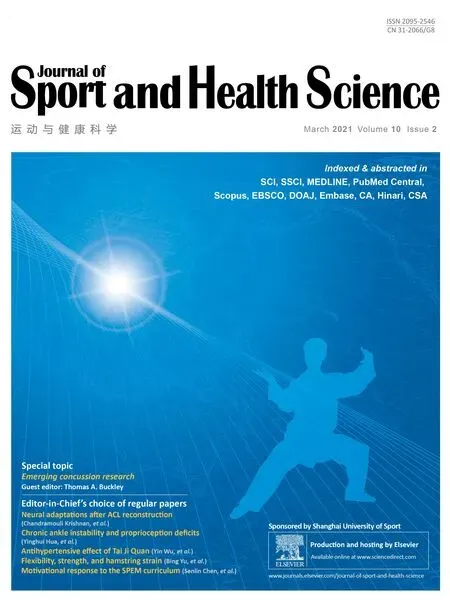Effects of medium-and long-distance running on cardiac damage markers in amateur runners:a systematic review,meta-analysis,and metaregression
Jobo 'A.Rubio-Aris*,Luis Andru,Luis Mnul Mrtínz-Arnd,Aljndro Mrtínz-Rodríguz,Pdro Mnonlls,Domingo J.Rmos-Cmpo
a Faculty of Sport,Catholic University of San Antonio(UCAM),Murcia 30107,Spain
b LFE Research Group,Department of Health and Human Performance,Faculty of Physical Activity and Sport Science-INEF,Universidad Polit'ecnica de Madrid,Madrid 28040,Spain
c International Chair of Sports Medicine,Catholic University of San Antonio(UCAM),Murcia 30107,Spain
d Neuroscience of Human Movement Research Group(Neuromove),Catholic University of San Antonio(UCAM),Murcia 30107,Spain
e Faculty of Sciences,University of Alicante,Alicante 03690,Spain
Abstract
Keywords: Endurance races;Troponin I;Troponin T;Ultra-endurance
1. Introduction
Light and moderate aerobic exercise has been promoted as a healthful physical activity (PA) associated with multiple benefits and a longer life expectancy. Although the controversy about its optimal dose continues, the scientific evidence suggests that the presence of any kind or level of PA is much better for an individual than a sedentary lifestyle.1,2Likewise,aerobic exercise generates positive effects on the cardiovascular system,3reducing, for example, events of coronary heart disease.4In fact, a longitudinal study with a large sample showed reductions in cardiovascular disease mortality (45%)and an increase in cardiovascular disease life expectancy (4.1 years) for runners compared to nonrunners.5Moreover, Arem et al.6reported that performing PA ≥10 times the minimum recommended by the official guidelines (≥75 metabolic equivalent task-h/week) is not associated with an increased mortality risk, but at the same time, this level of PA has a greater risk of all-cause mortality compared with moderate levels of PA.
Accordingly, endurance training for higher cardiorespiratory fitness levels(measured during cardiopulmonary exercise testing and expressed as maximum rate of oxygen consumption (VO2max)) is associated with numerous health benefits(e.g., longer lifespan, better quality of life, lower declination of functional and aerobic capacity, and reduced risks of allcause and cardiovascular mortality).7,8
Partly for these reasons, endurance and ultraendurance races, as PA practices, have become very popular, and the number of participants has increased in recent times.9However, extreme and competitive endurance events involve a considerably higher level of exercise than is recommended by the official guidelines,without being associated with the benefits that moderate PA could lead to in health status.10
Short-, medium-, and long-distance running races differ in terms of volume and intensity,can involve vigorous physical effort, and can generate changes in blood biomarkers caused by physiopathological events.11This type of PA can keep certain biomarkers elevated for days and damage an athlete’s health due to the appearance of rhabdomyolysis,12acute muscle damage and inflammation,13or cardiac damage.14In addition, it may increase the risk of the acute and transient effect of sudden cardiac death and acute myocardial infarction in susceptible populations.4
Several studies have investigated acute changes in biomarkers related to heart damage.14,15Troponin I (cTnI) and troponin T (cTnT) are highly specific “cardiac troponin”proteins (cTns) involved in myocardial cell damage and are key factors in the diagnosis of acute coronary syndromes and myocardial necrosis.16Stress situations may lead to a cTns increase in professional and recreational athletes without coronary disease, but the prevalence,17mechanisms,and clinical importance of exercise-induced cTns release are still not fully understood.
However, recent studies have shown that cTns increase after aerobic exercise,14,15in which high cardiac output, elevated heart rate,and increased blood pressure are required for several hours, resulting in greater cardiac work through myocardial work.17Some of the factors that can modify cardiac injury to a greater or lesser extent after this type of event may be associated with the characteristics of participants and running events. There is an individual variability in the cTnT response to acute exercise, depending on several potentially moderating factors(age,body mass,and VO2max).18
However, from a clinical point of view, health care staff must be aware of what may cause the elevation of cTns and which factors associated with the race and the person may have generated an increase in those markers after the end of long-distance running in an endurance event on foot.
Therefore, the purposes of the present systematic review and meta-analysis were to analyze: (1) the impact of medium- and long-distance running on the heart proteins,cTnI and cTnT, 24 h after the end of the race and (2) the moderating factors related to the race and to the runners’characteristics that could generate an increase in the final levels of cTnI and cTnT.
2. Methods
2.1. Study design
The methodological process was based on the recommendations indicated by the Preferred Reporting Items for Systematic Review and Meta-Analysis (PRISMA) declaration.19The study was preregistered in the PROSPERO with the following registered number:CRD42019129591.
2.2. Data sources and search profile
A comprehensive literature search was performed using PubMed-MEDLINE,Web of Science,and the Cochrane Library databases.The search was performed without date restriction and was completed on January 11,2019.The database searches were performed independently by 2 different authors(LA and J'ARA).The following combination of search terms was used:(“troponin-I” OR “troponin I” OR “troponin-T” OR “troponin T” OR“troponin*” OR “cardiac biomarkers”) AND (“marathon” OR“ultra-race”OR“ultra-distance”OR“ultra-marathon”OR“ultraendurance”OR“ultra-distance”OR“endurance”).
2.3. Data extraction and inclusion and exclusion criteria
In this review article,the following inclusion criteria were considered:(1)studies analyzing the acute effect of foot races on cardiac damage markers(cTnI and cTnT);and(2)studies analyzing cardiac damage markers before and after the race. Studies were excluded if they included (1) populations with pathologies, (2)case studies, (3) studies where the training or the race was performed on a treadmill,(4)studies written in languages other than English or Spanish, (5) running events performed intermittently,and(6)runners who took supplements or medications.
2.4. Study variables
The levels of cTnT and cTnI were the study variables on which the effects of endurance racing (endurance race(10-20 km), mountain race, half marathon, marathon, ultramarathon, or mountain ultramarathon) were analyzed. These markers are considered to be indicators of acute coronary syndrome, and their elevation is usually associated with cardiac pathologies;however,they are also sensitive to stressful situations such as endurance races.20,21
2.5. Evaluation of the methodology of the studies selected(risk of bias)
The methodological quality of the selected studies was assessed by the quality-assessment tool used for before-after(pre-post)studies with no control group (National Heart Lung and Blood Institute),22which analyzes the following items:(1)study question;(2)eligibility criteria and study population; (3) representativeness of study participants from clinical populations of interest; (4) enrolment of all eligible participants;(5)sample size;(6)clear description of the intervention; (7) outcome measures clearly described,valid,and reliable;(8)blinding of outcome assessors;(9)follow-up rate;(10)statistical analysis;(11)multiple outcome measures;and(12)group-level interventions and individual-level outcome efforts.For all the studies,each item was described as having either a low risk of bias, an unclear risk of bias, or a high risk of bias. Two different authors (LA and DJRC) used the previously described risk-of-bias tool to assess the risk of bias independently.
2.6. Data synthesis and statistical analysis
The meta-analysis and the statistical analysis were conducted using Review Manager software (Version 5.2; RevMan,Cochrane Collaboration, Oxford, UK). A random-effects meta-analysis was conducted to determine the effects of endurance races on cardiac damage markers.The effects of these race events were expressed as mean differences(MDs)and their 95%confidence intervals (95%CIs). The heterogeneity between the studies was evaluated through the I2statistic, and the betweenstudy variance was evaluated using the Tau2(τ2).23The I2values of 30%-60% represented a moderate level of heterogeneity. In addition,a τ2value >1 suggests the presence of substantial statistical heterogeneity.The Egger’s test was used to assess publication bias.24p ≤ 0.05 was considered to be statistically significant.
2.7. Effects of moderator variables:metaregression and subanalysis
2.7.1. Moderator analysis for dichotomous variables
To explore the heterogeneity among the variance of the studies, a metaregression of the continuous variables was applied. Considered as moderating variables were age, body mass index (BMI), distance covered, time to complete the race, and speed. The metaregression was analyzed by a random-effects model using the Jamovi Project(Package for R(Version 1.0.0;R Development Core Team,Vienna,Austria)).A restricted maximum residual plausibility method was used to measure variance between studies(τ2).
2.7.2. Subgroup analysis for dichotomous variables
Subgroup analysis was applied using Review Manager software, with gender and type of race used as dichotomous/politomous variables that could have an influence on the heterogeneity.
In addition, distance and time were analyzed under a dichotomous model (establishing the median as the cut-off point).In each study,the MDs of pre-and post-race,and 24 h after the race were calculated. Each difference in mean was pondered using the method of the inverse variance.25
3. Results
3.1. General characteristics of the studies
To measure the impact of running on the level of cTnI,statistical analysis was performed on 25 studies with 32 groups;and to measure the level of cTnT,it was performed on 26 studies with 33 groups (Fig. 1). The mean age of the participants was 40.4 years(range:15.7-63.4 years)in cTnI and 41.1 years(range: 15.7-63.0 years) in cTnT. Participants had a mean BMI of 23.4±1.5 kg/m2(mean±SD)in the cTnI groups and 22.8±1.9 kg/m2in the cTnT groups.The descriptive characteristics and references can be seen in Supplementary Table 1.
3.2. Risk of bias and heterogeneity
The score obtained(median)in the risk analysis was 7/9(Supplementary Table 2). The funnel test showed heterogeneity of studies(Fig.2).In addition,a significant bias was observed in the cTnI (Fig. 2A) for the 32 groups analyzed by using the Egger’s test (Z=4.67, p <0.001). However, the bias was not significant in the cTnT (Fig. 2B) for the 33 groups analyzed (Z=1.54,p=0.123).
3.3. Meta-analysis
The overall effect of running on cTnI(Fig.3)was analyzed in 825 runners.The races generated a significant post-race increase in cTnI levels (MD=0.0381 ng/mL, 95%CI: 0.0333-0.0428, p<0.001).Likewise,the effect of races on cTnT for 1195 runners displayed a significant postrace increase (MD=0.0256 ng/mL,95%CI:0.0231-0.0282,p <0.001).
3.4. Metaregression results
The results of the metaregression are shown in Table 1(cTnI)and Table 2(cTnT).A negative interaction was observed among cTnI,age(adjusted R2=14.4%;τ2=0.0022),and BMI(adjusted R2=14.5%;τ2=0.0018).
3.5. Sub-group results
The overall effect of running on cTnI remained high until 24 h,when the effect on markers became significantly reduced(x2= 149.28, p <0.001). Similarly, the effect of the race on the cTnT remained high until 24 h); then it showed a significant decrease (x2= 4.21, p=0.04) (Table 3). In addition,there was a greater increase in cTnI than in cTnT (x2=20.49,p <0.001) post-race. However, higher cTnT values were observed at 24 h(x2=4.87,p=0.03).
3.6. Gender
When studies were grouped by gender(Table 3),the differences of the increases in the observed cTnI values (x2=56.51,p <0.001)were higher in the studies involving men and women(n=502 participants; MD=0.071 ng/mL, 95%CI: 0.058-0.085,p <0.001) and in the studies involving only men (n=323 participants;MD=0.018 ng/mL,95%CI:0.014-0.021,p <0.001).However, no differences in cTnT values (x2=0.01, p=0.92)were observed in men or in studies involving men and women.Only 2 studies (3 groups) that analyzed the effect of endurance races in women were identified, and when they were added to the analysis, a significant increase in cTnT was observed(n=108 participants; MD=0.014 ng/mL, 95%CI: 0.008-0.020,p <0.001). However, this increased response in women was lower compared to men (x2=15.55, p <0.001) and compared to studies involving men and women(x2=7.75,p=0.005).
3.7. Type of competition
Significant differences in cTnI were observed depending on the type of event (x2=96.19, p <0.001) (Table 3). The highest postcompetition cTnI values were observed for marathon(n=627;MD=0.062 ng/mL, 95%CI: 0.055-0.070, p <0.001), followed by the half marathon (n=87; MD=0.046 ng/mL, 95%CI:0.013-0.078, p=0.006), and the mountain ultramarathon (n=34;MD=0.023 ng/mL,95%CI:0.009-0.037,p=0.001).In addition,when speed and exposure time were analyzed under a dichotomous model,significant differences were observed in cTnI(Fig.2),with higher values for runners running at lower speeds than for those running at higher speeds (x2=14.58, p=0.0001) and for those completing the route in a longer time than for those completing it in a shorter time(x2=6.32,p=0.01)(Table 3).

Fig.1. Preferred Reporting Items for Systematic Reviews and Meta-Analyses(PRISMA)flow diagram of included and excluded studies.

Fig.2. Assessment of risk of bias for included studies(funnel plot):(A)mean differences for troponin I and(B)mean differences for troponin T.
4. Discussion
4.1. Persistence over time
The obtained results showed a significant increase in posteffort cTns, which remained elevated until 24 h post effort. In line with this finding,previous studies have indicated that sustained efforts of long duration and intensity generate significant and reversible increases in the release of posteffort cTns,so the effect of cardiac necrosis is not ruled out due to repeated efforts over time.26,27A transient increase in the membrane permeability has been proposed as an alternative hypothesis to necrosis.28However, the effect of continuous exposure to these markers is not yet known. Our results suggest a greater sensitivity of the cTnI to the effect of races and higher cTnT levels over time,with a reversible effect.

Fig.3. Effects of running races on cardiac damage markers:(A)forest plot for troponin I and(B)forest plot for troponin T.The references of the studies included in the quantitative analysis are summarized in Supplementary Table 1.CI=confidence interval;G1=Group 1;G2=Group 2;G3=Group 3;G4=Group 4;G5=Group 5;IV=inverse variance;SD=standard deviation.

Table 1 Metaregression analysis of troponin I.

Table 2 Metaregression analysis of troponin T.
4.2. Age
Regarding the ages of participants,our results revealed a significant and negative interaction for age on cTnI (adjusted R2=14.4%),with no interaction on cTnT.This significant negative interaction is in line with findings in previous studies.29In a similar meta-analysis,26the authors did not find any relationship between the release of cTnT and the ages and genders of participants, which is in agreement with the results obtained in our study.However,Fortescue et al.30observed that troponin values were higher in younger and less well-trained runners. The athletes included in the meta-analysis had a mean age of 40.4 years,ranging between 15.7 years and 63.4 years for cTnI;and of 41.1 years,ranging between 15.7 years and 63.0 years for cTnT,with a greater number of studies at greater age intervals.One possible explanation for these results is based on the increase in the cardiac output and,in addition,the relationship between age and the cardiac remodeling due to exercise.It is known that amateur athletes may suffer from both effects in response to aerobic exercise.31-33These factors could generate less myocardial stress during acute efforts.Another possible explanation could be the number of athletic competitions included in the studies.Several studies suggest that with repeated exercise,30,34stress-sensitive muscle fibers can be eliminated through cell necrosis followed by regeneration. Regeneration of muscle fibers and changes in connective tissue may protect against exercise-related aggressions and the release of myofibrillary enzymes.If such remodelling occurred in the heart, this conditioning could explain the tendency of more experienced and older runners to be relatively less likely to exhibit cTns release.
4.3. BMI
BMI showed a significant and negative interaction with cTnI(adjusted R2=14.5%). However, no interactions were observed for the total amount of released cTnT. Similarly, Shave et al.26observed that in long-term events, the amount of released cTnT was related to body weight.To our knowledge,few studies have attempted to relate BMI values to the level of released cTns. As previously shown, anthropometric characteristics are related to aerobic performance in endurance runners.35Therefore,this association could be due to the fact that BMI is associated with weight.Moreover,in amateur athletes,the BMI value is associated with a higher percentage of fat mass,which could be related to a lower running speed, leading to a lower intensity of effort during the race and resulting in a lower myocardial effort.

Table 3 Effects of endurance races:subgroup analysis.
4.4. Gender
A significant interaction was shown between 2 subgroups in the studies that included men only and those that included both men and women.For cTnT,only 2 studies analyzed the effect of endurance races for women,36,37where the cTnT released in women was lower than that in men. These results are consistent with previous studies showing that cardiac function in exertion depends on several factors,for example,gender.38
A putative explanation for these results could be that a lower diastolic capacity is related to a poorer sports performance,and other factors, such as age and gender, may be related to lower systolic capacity.39The difference in ventricular capacity may lead to a decrease in ventricular stress and,therefore,less heart damage.Another explanation for the differences related to gender could be the differing estrogen levels in men and women which,in this case,act as a protector of the myocardium.40Yet another explanation may be the difference in heart size; it is known that after puberty, there are differences in heart size between the genders.37,41In addition,healthy women show better diastolic and systolic function compared to men of the same age,42which may be conditioning the effect on stress during exercise. It has also been shown that coping strategies may weaken with age,depending on gender.39
However,cTnI values in men were significantly lower than in combined groups of men and women. This inconsistency with previous results could be explained by the fact that men’s groups completed races of an average duration of 929 min(range:80-3758 min),whereas groups consisting of both genders completed races of an average duration of 205 min (range:58-293 min), with an average race distance of 69.2 km (range:21.1-308.0 km) for men and 33.9 km (range: 10.0-42.2 km)for women. Therefore, the intensities at which the events took place were higher,which may affect the results.43
4.5. Distance,intensity,and type of event
According to the metaregression, our results revealed that there is no interaction between the total level of released cTns and the distance, time, and speed variables. However, when the cTnI levels were analyzed as a function of the cut-off point(median), a significant interaction was observed between velocity and time. Participants who covered longer distances (who,therefore, had more time of exposure to effort) had greater and significant increases (x2=6.32, p=0.01) than did those who were exposed for less time (and who, therefore, covered shorter distances). In addition, when analyzing the types of events, we observed that intensity was a key factor in the release of cTnI.The runners who covered the marathon distance released the largest amounts of cTnI, followed by those who completed the half marathon. In addition, nonsignificant differences for the endurance race (10-20 km) and the ultramarathon were found,and significant differences were reported for the ultramarathonmountain. These results suggest that a minimum time of highintensity exposure is necessary to generate a significant release of cTnI. If the race is not long enough (≥half-marathon distance)15or is not performed at a certain intensity, no significant levels of cTns will be generated. Our results are consistent with the results previously found in other studies.15,43,44
Legaz-Arrese et al.45observed that a certain intensity must be maintained over a certain period of time to generate a significant release of cTnI, indicating that the specific release kinetics are not known to be exponential. This fact coincides with the cardiac adaptations that could be produced in the long term and be harmful to health.46
One of the limitations of our analysis is that it did not consider the methods of obtaining the cTns levels(due to missing information in the articles),and there could have been a loss in the sensitivity when obtaining the preanalysis values.47Another limitation is that there was little information available in the included studies that mentioned the athletes’experience,and runners’ experience is one of the limiting factors for the determination of the cTns levels.48However, the level of the participants’ experience identified in the studies included in our analysis was too vague to establish it as a categorical factor in our analysis.In addition,the collection time for blood samples was immediately after the race in many of the analyzed studies, and it has been observed that the cTns level peaks at approximately 4 h following a race.21Finally, it is important to highlight the fact that an elevated degree of heterogeneity was shown in the analysis,which was probably due to the factors mentioned above.
5. Conclusion
A few studies have shown the effect of endurance running on cardiac damage markers.It is known that there can be an interaction between a study population’s characteristics and a running event’s characteristics on the measured cTns levels,but thus far,relevant studies have been limited and have had small sample sizes.
To our knowledge, this is the first meta-analysis that analyzed the effects of foot races and the factors that generate greater cTns release in amateur athletes. The main findings in our analysis were that endurance races generate an increase of cTnI and cTnT releases, which remain at high levels for at least 24 h.In addition,several moderating variables that affect cTns levels after long-distance running were identified.
Endurance foot races generate increased markers of heart damage and persist at high levels for a minimum of 24 h afterward. Gender, duration of effort, speed, and type of race are moderating factors related to levels of cTnI release.
It is recommended that runners be adequately prepared for certain types of competitions, especially those that combine long duration and moderate intensity (i.e.,marathons). This is true especially for men and inexperienced or young participants who have high fat percentages or high BMIs.
As a clinical application,previous studies suggest that caution should be taken with those people who show high values in cardiac damage markers after running49because these markers could be the result of exposure to vigorous exercise.
Amateur runners who have these characteristics should be warned about the risk of performing aerobic events at vigorous intensity. In addition, it has been observed that cTnI is more responsive to the effect of certain moderating variables;this may be because it is a more sensitive marker in relation to the effects of running.However,this difference could be due to the lack of initial heterogeneity of the cTnT results. Finally, we must point out that our message is not about running being harmful to health but,rather,that the acute effects caused by endurance races with certain features may increase in people with certain characteristics.From a clinical point of view,this information is relevant for health care professionals because it provides information about how an acute situation can be exacerbated when the aforementioned characteristics are present. For this reason, it is recommended that runners be adequately trained and prepared in order to fully benefit from the positive effects of PA and to minimize the acute effects of running.
Acknowledgment
The authors thank G.Sanz for proofreading.
Authors’contributions
J'ARA performed the study design,literature search,and statistical analysis and drafted the manuscript; LA performed the literature search,helped with the data interpretation and the analysis of the results; LMMA participated in the design and coordination of the study and performed the draft, writing-review, and editing of the manuscript;AMR supervised the study design and statistical analysis and revised the manuscript; PM interpreted the data and revised the manuscript; DJRC conceived and designed the study,provided advice with data processing,and revised the manuscript draft.All authors have read and approved the final version of the manuscript,and agree with the order of the presentation of authors.
Competing interests
The authors declare that they have no competing interests.
Supplementary materials
Supplementary material associated with this article can be found in the online version at doi:10.1016/j.jshs.2019.10.003.
 Journal of Sport and Health Science2021年2期
Journal of Sport and Health Science2021年2期
- Journal of Sport and Health Science的其它文章
- Factors associated with concussion-symptom knowledge and attitudes toward concussion care seeking in a national survey of parents of middle-school children in the US
- Effects of purposeful soccer heading on circulating small extracellular vesicle concentration and cargo
- The diagnostic and prognostic utility of the dual-task tandem gait test for pediatric concussion
- Impaired eye tracking is associated with symptom severity but not dynamic postural control in adolescents following concussion
- Slowed driving-reaction time following concussion-symptom resolution
- Impaired motor control after sport-related concussion could increase risk for musculoskeletal injury:Implications for clinical management and rehabilitation
